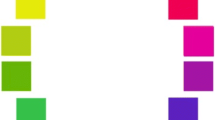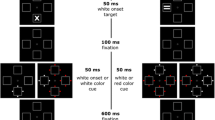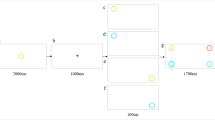Abstract
Visual search studies have shown that attention can be top-down biased to a specific target color, so that only items with this color or a similar color can capture attention. According to some theories of attention, colors from different categories (i.e., red, green, blue, yellow) are represented independently. However, other accounts have proposed that these are related—either because color is filtered through broad overlapping channels (4-channel view), or because colors are represented in one continuous feature space (e.g., CIE space) and search is governed by specific principles (e.g., linear separability between colors, or top-down tuning to relative colors). The present study tested these different views using a cueing experiment in which observers had to select one target color (e.g., red) and ignore two or four differently colored distractors that were presented prior to the target (cues). The results showed clear evidence for top-down contingent capture by colors, as a target-colored cue captured attention more strongly than differently colored cues. However, the results failed to support any of the proposed views that different color categories are related to one another by overlapping channels, linear separability, or relational guidance (N = 96).






Similar content being viewed by others
References
Ansorge, U., & Becker, S. I. (2012). Automatic priming of attentional control by relevant colors. Attention, Perception, & Psychophysics, 74, 83–104.
Anderson, B. A., & Folk, C. L. (2010). Variations in the magnitude of attentional capture: Testing a two-process model. Attention, Perception, & Psychophysics, 72, 342–352.
Ansorge, U., & Heumann, M. (2003). Top-down contingencies in peripheral cuing: The roles of color and location. Journal of Experimental Psychology: Human Perception and Performance, 29, 937–948.
Ansorge, U., & Heumann, M. (2004). Peripheral cuing by abrupt-onset cues: the influence of color in S-R corresponding conditions. Acta Psychologica, 116(2), 115–143.
Ansorge, U., & Horstmann, G. (2007). Preemptive control of attentional capture by color: Evidence from trial-by-trial analysis and ordering of onsets of capture effects in RT distributions. Quarterly Journal of Experimental Psychology, 60, 952–975.
Ansorge, U., Kiss, M., & Eimer, M. (2009). Goal-driven attentional capture by invisible colors: Evidence from event-related potentials. Psychonomic Bulletin & Review, 16, 648–653.
Awh, E., Belopolsky, A. V., & Theeuwes, J. (2012). Top-down versus bottom-up attentional control: A failed dichotomy. Trends in Cognitive Science, 16, 437–443.
Bauer, B. G., Jolicoeur, P., & Cowan, W. (1998). The linear separability effect in color visual search: Ruling out the additive color hypothesis. Perception & Psychophysics, 60, 1083–1093.
Becker, S. I. (2007). Irrelevant singletons in pop-out search: Attentional capture or filtering costs? Journal of Experimental Psychology: Human Perception and Performance, 33, 764–787.
Becker, S. I. (2010a). The role of target–distractor relationships in guiding attention and the eyes in visual search. Journal of Experimental Psychology: General, 139, 247–265.
Becker, S. I. (2010b). Oculomotor capture by irrelevant colour singletons depends on intertrial priming. Vision Research, 50, 2116–2126.
Becker, S. I., Ansorge, U., & Horstmann, G. (2009). Can intertrial priming account for the similarity effect in visual search? Vision Research, 49, 1738–1756.
Becker, S. I., Folk, C. L., & Remington, R. W. (2010). The role of relational information in contingent capture. Journal of Experimental Psychology: Human Perception and Performance, 36, 1460–1476.
Eckstein, M., Drescher, B., & Shimozaki, S. S. (2006). Attentional cues in real scenes, saccadic targeting, and Bayesian priors. Psychological Science, 17, 973–980.
Eimer, M., & Kiss, M. (2008). Involuntary attentional capture is determined by task set: Evidence from event-related brain potentials. Journal of Cognitive Neuroscience, 20, 1423–1433.
Einhäuser, W., Spain, M., & Perona, P. (2008). Objects predict fixations better than early salience. Journal of Vision, 8, 1–26.
Fecteau, J. (2007). Priming of pop-out depends on the current goals of the observers. Journal of Vision, 7, 1–11.
Folk, C. L., & Remington, R. W. (1998). Selectivity in distraction by irrelevant featural singletons: Evidence for two forms of attentional capture. Journal of Experimental Psychology: Human Perception and Performance, 24, 847–858.
Folk, C. L., & Remington, R. W. (2008). Bottom-up priming of top-down attentional control settings. Visual Cognition, 16, 215–231.
Folk, C. L., Remington, R. W., & Johnston, J. C. (1992). Involuntary covert orienting is contingent on attentional control settings. Journal of Experimental Psychology: Human Perception and Performance, 18, 1030–1044.
Fortier-Gauthier, U., Dell’Acqua, R., & Jolicœur, P. (2013). The “red-alert” effect in visual search: Evidence from human electrophysiology. Psychophysiology (in press).
Geyer, T., Krummenacher, J., & Müller, H. J. (2008). Expectancies modulate attentional capture by salient color singletons. Vision Research, 48, 1315–1326.
Gilbert, A. L., Regier, T., Kay, P., & Ivry, R. B. (2006). Whorf hypothesis is supported in the right visual field but not in the left. Proceedings of the National Academy of Sciences of the United States of America, 103, 489–494.
Grubert, A., & Eimer, M. (2013). Qualitative differences in the guidance of attention during single-colour and multiple-colour visual search: Behavioural and electrophysiological evidence. Journal of Experimental Psychology: Human Perception and Performance (in press).
Harris, A., Remington, R. W., & Becker, S. I. (2013). Feature-specificity in attentional capture by size and colour. Journal of Vision (in press).
Hodsoll, J. P., & Humphreys, G. W. (2005). The effect of target foreknowledge on visual search for categorically separable orientation targets. Vision Research, 45, 2346–2351.
Irons, J. L., Folk, C. L., & Remington, R. W. (2012). All set! Evidence of simultaneous attentional control settings for multiple target colors. Journal of Experimental Psychology: Human Perception and Performance, 38, 758–775.
Itti, L., & Koch, C. (2001). Computational modelling of visual attention. Nature Reviews Neuroscience, 2, 4–11.
Kim, M.-S., & Cave, K. (1999). Top-down and bottom-up attentional control: On the nature of interference from a salient distractor. Perception & Psychophysics, 61, 1009–1013.
Maljkovic, V., & Nakayama, K. (1994). Priming of pop-out: I. Role of features. Memory & Cognition, 22, 657–672.
Müller, H. J., Geyer, T., Zehetleitner, M., & Krummenacher, J. (2009). Attentional capture by salient color singleton distractors is modulated by top-down dimensional set. Journal of Experimental Psychology: Human Perception and Performance, 35, 1–16.
Navalpakkam, V., & Itti, L. (2007). Search goal tunes visual features optimally. Neuron, 53, 605–617.
Theeuwes, J. (1992). Perceptual selectivity for color and form. Perception & Psychophysics, 51, 599–606.
Theeuwes, J., Atchley, P., & Kramer, A. F. (2000). On the time course of top-down and bottom-up control of visual attention. In S. Monsell & J. Driver (Eds.), Attention and performance XVIII (pp. 105–125). Cambridge: MIT Press.
Töllner, T., Müller, H., & Zehetleitner, M. (2012). Top-down dimensional weight set determines the capture of visual attention: Evidence from the PCN component. Cerebral Cortex, 22, 1554–1563.
Torralba, A., Oliva, A., Castelhano, M. S., & Henderson, J. M. (2006). Contextual guidance of eye movements and attention in real-world scenes: The role of global features in object search. Psychological Review, 113, 766–786.
Witzel, C., & Gegenfurtner, K. R. (2011). Is there a lateralized category effect for color? Journal of Vision, 11(12), 16.
Wolfe, J. M. (1994). Guided search 2.0: A revised model of visual search. Psychonomic Bulletin & Review, 1, 202–238.
Worschech, F., & Ansorge, U. (2012). Top-down search for color prevents voluntary directing of attention to informative singleton cues. Experimental Psychology, 59, 153–162.
Yantis, S., & Hillstrom, A. P. (1994). Stimulus-driven attentional capture: Evidence from equiluminant visual objects. Journal of Experimental Psychology: Human Perception and Performance, 10, 601–621.
Acknowledgments
Supported by project number CS11-009 of the WWTF (Wiener Wissenschafts- und Technologiefonds) to Ulrich Ansorge, Otmar Scherzer, and Shelley Buchinger, and an ARC (Australian Research Council) Discovery Grant DP110100588 awarded to Stefanie I. Becker.
Author information
Authors and Affiliations
Corresponding author
Appendix
Appendix
See Table 1.
Rights and permissions
About this article
Cite this article
Ansorge, U., Becker, S.I. Contingent capture in cueing: the role of color search templates and cue-target color relations. Psychological Research 78, 209–221 (2014). https://doi.org/10.1007/s00426-013-0497-5
Received:
Accepted:
Published:
Issue Date:
DOI: https://doi.org/10.1007/s00426-013-0497-5




